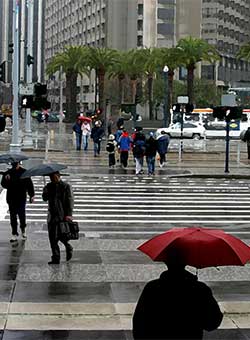 Despite offering a good starting point, there’s still plenty of information missing when you look at the Walkscore of a specific location. As has been pointed out plenty of times there are some serious limitations when it comes to the most prominently cited rankings of a neighborhood’s walkability. In addition to not considering factors like street design, crime, topography, and pedestrian safety, a Walkscore rating can also fail to make qualitative judgments about the location’s surroundings; potentially weighing a short walk to a rundown convenience store the same way it would a close proximity to an actual grocery store.
Despite offering a good starting point, there’s still plenty of information missing when you look at the Walkscore of a specific location. As has been pointed out plenty of times there are some serious limitations when it comes to the most prominently cited rankings of a neighborhood’s walkability. In addition to not considering factors like street design, crime, topography, and pedestrian safety, a Walkscore rating can also fail to make qualitative judgments about the location’s surroundings; potentially weighing a short walk to a rundown convenience store the same way it would a close proximity to an actual grocery store.
In an effort to fill the void and offer another way to measure a city’s true walkability, Adam Davies has launched the site (and app) Walkonomics. The site, which includes data for San Francisco (along with Manhattan) as part of its recent launch, is attempting to gauge walkability not just in terms of what’s in the area, but how pleasant the pedestrian experience actually is.
The goal is to offer a truer sense of walkability by digging into the following categories:
- Safety
- Number of crosswalks
- Quality of sidewalks
- Hilliness
- Ease of navigation
- Fear of crime
- Aesthetics
- and, Popularity of the location
Intuitively, this seems like a great way to determine whether a location is truly walkable. After all, no amount of nearby attractions will have you eager to set off on foot if you don’t feel safe. However, successfully measuring this criteria seems easier said than done.
So far, browsing through a few San Francisco locations, the limited ratings pre-filled by Walkonomics’ “WalkoBot” don’t really give a strong sense for the area’s walkability. In major downtown areas, crime stats seem to be overly weighted, making even the most central location appear as if it’s a 2.5 out of 5. If the site gathers some traction in the coming months it’s likely additional reviews will help even out the kinks, but for now it’s a metric that seems great in theory but almost entirely useless in execution.
Both Walkscore and Walkonomics highlight the difficulties in assessing exactly what it means for an area to be “highly walkable.” Different people define it completely differently, and while some might say hilly terrain makes a particular route completely undesirable, others might be fine embarking on an “urban hike” if it means not having to hop on the bus or get in their car.
As Walkscore amusingly points out when discussing their own shortcomings, “as [one commenter] said, ‘You should use the Web 3.0 app called going outside and investigating the world for yourself’ before deciding whether a neighborhood is walkable!” We couldn’t agree more.

